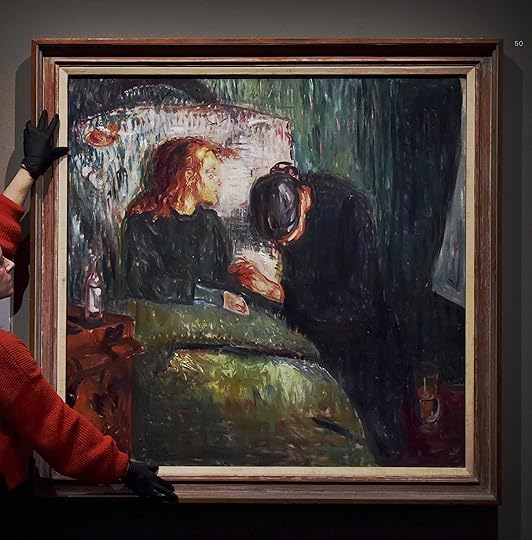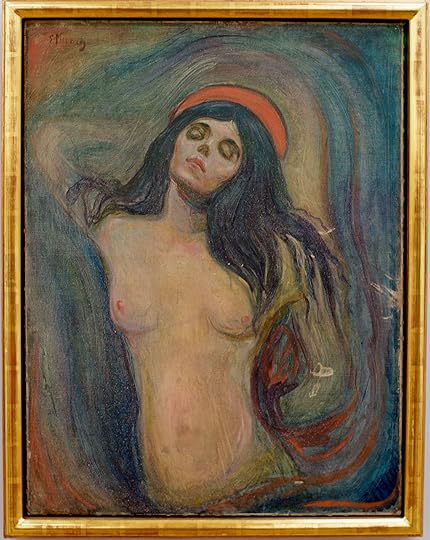Art Lovers discussion
Introduce an Artist and/or Work
>
Beyond ‘The Scream’: How Edvard Munch Channeled a Timeless Sense of Dread
date newest »
newest »
 newest »
newest »
 The Scream is one of the most recognizable—and one of the most parodied—artworks in history, and because of its outsized reputation, it’s now considered Edvard Munch’s masterpiece. But Munch himself never considered it his magnus opus. He finished the first version of The Scream in 1893, and his career stretched on for 50 years afterward.
The Scream is one of the most recognizable—and one of the most parodied—artworks in history, and because of its outsized reputation, it’s now considered Edvard Munch’s masterpiece. But Munch himself never considered it his magnus opus. He finished the first version of The Scream in 1893, and his career stretched on for 50 years afterward.The raw nerves glimpsed in The Scream make it an outlier in Munch’s oeuvre—most of his works accept mortality with a grim resolve. Part of their power lies in the tension between the violent strokes and mournfulness of his subjects. A dread surrounding modern life suffuses Munch’s work—and explains the resilience of its appeal. Our present little resembles his own, but the sense of isolation, regret, and decline in his work is timeless.
“In my art I attempt to explain life and its meaning to myself,” Munch wrote of his creative mission. It’s a useful frame to interpret his artwork: not records of life as it was, but as it felt to live.
 The Early Years
The Early Years“I learned early about the misery and dangers of life, and about the afterlife, about the external punishment which awaited the children of sin in Hell,” he once wrote. By his own accounts, Munch did not have a happy childhood, and he returned to its most traumatic events often in painting. He was born in 1863 in a farmhouse in a village in Norway. His mother died of tuberculosis, which also claimed his favorite sister, Sophie, as a teen.
He and his surviving siblings were raised by his aunt and father in Oslo in a household ruled by his father’s “obsessive” piety. As a young boy, he suffered from asthmatic bronchitis and was often kept home from school, entertaining himself with the ghost stories of Edgar Allen Poe, whose Romantic writings underline Munch’s own macabre preoccupations. The specter of mental illness was always near in Munch’s art, as it was in his own life—his older sister, Laura, was institutionalized for depression.
He enrolled in 1881 at the Royal School of Art and Design of Kristiania (now Oslo). Munch displayed an early aptitude for figure drawing, and in1883 took part in his first public exhibition. The featured work, a full-length portrait of local bohemian Karl Jensen-Hjell, was decried by critics, who called it “impressionism carried to the extreme” and a “travesty of art.” This marked the beginning of a contentious relationship between Munch and his countrymen, whose approval he both spurred and craved. He found kinship in the company of Hans Jæger, a Norwegian anarchist, whose nihilistic outlook complimented Munch’s own growing pessimism. He instructed the young artist to “write his life,” spurring a period of self-examination.


Edvard Munch, The Sick Child, 1907
Among the Impressionists
Munch arrived in Paris in 1885 to study in the studio of Léon Bonnat, who taught Henri de Toulouse-Lautrec, Gustave Caillebotte, John Singer Sargent, and other major figures of the era. He found Bonnat’s drawing lessons “numbing,” but the experience exposed him to Claude Monet, Paul Gauguin, and others. Munch once wrote that he appreciated the latter’s art for its glorious “reaction against realism.” The use of color by Monet, Gauguin, and other Impressionists and Post-Impressionists signified emotion in expressive ways, and for Munch, that was an inspiration, even if their comparatively light-hearted subject matter differed from his own.
At this time, Munch began six paintings and lithographs based on Sophie’s death titled The Sick Child. They depict his sister on her deathbed, her face pallid and haunted as she clutches the hands of grief-stricken woman, likely their aunt Karen, whose eyes are averted in despair. The rough, vertical brushstrokes in the paintings lend a hazy veil, as though they are being seen during a dream. Munch deemed this the first “soul painting” in his oeuvre, and it marked a definitive shift toward a mode that would come to be known as Symbolism, which relied on form, color, and composition to offer an emotionally driven break with reality.
Munch wrote of the experience: “I started as an Impressionist, but during the violent mental and vital convulsions of the Bohême period Impressionism gave me insufficient expression—I had to find an expression for what stirred my mind … The first break with Impressionism was the Sick Child—I was looking for expression.”
The scene would repeat itself in Death in the Sickroom (1893) and the masterful Love and Pain (1895), later retitled Vampire by its viewers. In the latter work, a red-haired woman comforts an anguished man in her embrace. She bends to kiss his neck or lay her head on his shoulder. Compared to The Sick Child, where the people shown are still depicted in a manner that resembles life itself, the figures in Death in the Sickroom and Love and Pain are simplified, and their faces are deformed, crowded by claustrophobic brushstrokes.
 The Berlin Years
The Berlin Years
The Norwegian art establishment, with its affinity for naturalism, reviled Munch’s early work. But in Germany, where he lived from 1892 to 1908, Munch carved out an international career. After his solo show in Berlin in 1892 was shuttered by conservatives, he cannily leveraged the controversy—which became known as the “Munch affair”—into invaluable publicity....
The Midnight Sun

Amid all this, Munch suffered from depression. That plus a period of heavy drinking led the artist to have a nervous breakdown in 1908. He was institutionalized in Copenhagen for eight months, a period which considerably stabilized his mood. He returned to Norway the following year and took up landscapes with a preference for warm colors and loose brushwork...
Artist as Subject
Despite the newfound levity of his painting, Munch never shook his obsession with his own mortality. Until his death in 1944, he continued to chronicle the ugliness of his aging. The startled, dapper young man in Self Portrait With Cigarette (1895) transforms soon after into the half-human creature of Self-Portrait in Hell (1903), in which Munch shows himself naked amid flames. His face appears mottled beneath a series of brown strokes, but he shows no sign that he is afraid, even despite his hellish setting...
More....https://www.artnews.com/feature/edvar...



by Tessa Solomon
ARTnews
March 17, 2021
Edvard Munch, Love and Pain, 1895.